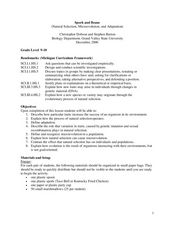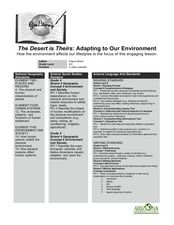Curated OER
Venus Flytrap
Students study the Venus Flytrap including its habitat and how it eats. In this ecology lesson students complete several experiments using a Venus Flytrap to see how it reacts to various conditions.
Curated OER
Spork and Beans
Students examine natural selection, how it works and how it can cause microevolution. In this evolution lesson students complete a lab activity that shows the effects that natural selection has on organisms.
Curated OER
The Birds and the Beaks
Young scholars explore the adaptations that birds have. In this adaptations lesson students view a video and create a concept map of birds and their adaptive traits.
Curated OER
It's a Jungle Out There: How Species Survive in the Jungle
Students investigate the different adaptation and skills of jungle species. In this ecology instructional activity, students play an interactive online game where they match species with their adaptation. They research about a specific...
Curated OER
Ecology Lessons
Students examine the relationship between animal adaptations, habitats and community interactions. In this ecology instructional activity students complete a skull detective worksheet then use their knowledge to analyze a skull.
Curated OER
The Perfect Cow?
High schoolers examine how cattle have evolved through natural selection and selective breeding. In this natural selection lesson students compare and contrast natural and artificial selection.
Curated OER
Awesome Adaptations!
Second graders explore biology by researching animal characteristics. For this adaptation lesson, 2nd graders identify the history of several animals and research the changes that have occurred to their anatomy over thousands of years....
Curated OER
Animal Adaptations
Students focus on the pelts of fur-bearing animals native to Iowa to discover their different adaptations. In this animal adaptation lesson, students work in groups and examine various pelts to find information about the animals habitat...
Curated OER
Creepers and Climbers
Students compare vines. In this vines lesson, students analyze the adaptations common in vines. Students determine if the vine grows using tendrils, modified roots, or twining stems. Students explore a forest area to flag different vines...
Curated OER
The Amazing Octopus
Young scholars design imaginary animals that are able to blend into their backgrounds. In this biology lesson plan, students will learn the importance of camouflage in protecting animals from predators. Young scholars will select a peer...
Curated OER
Wolves At Our Door
Students investigate the wolf. In this animal adaptation lesson, students examine the social characteristics of the wolf. They discuss the role of human intervention in reestablishing the wolf population.
Curated OER
Blue Planet: Frozen Seas
Students study the animals from the Arctic and how they have adapted. In this ocean lesson students create a poster about their given animal and present it to the class.
Curated OER
What Does it Take to be a Survivor? Part One
Young scholars explore marine animal adaptation. In this introductory ocean life biology instructional activity, students access prior knowledge by participating in a whole class "thought swap." Young scholars form two lines, respond to...
Curated OER
Fish Fashion 101
Learners explore fish anatomy. In this fish anatomy and adaptation lesson, students define and identify the location of fish body parts. Learners add these parts of a fish's anatomy to a life-sized fish costume worn by a student. ...
Curated OER
Ocean Exploration
Students explore whales. In this animal adaptation and whale instructional activity, students access prior knowledge about whales from previous lessons, then use background knowledge to predict the eating strategies of a baleen whale and...
Curated OER
Build a Hawaiian Bird
Fifth graders make a model of a bird. For this animal adaptations lesson, 5th graders examine how birds adapt to their environment, using Hawaiian birds as an example. Students create their own bird using adaptation paper cut outs then...
Curated OER
Hidden Animals
Students predict the safest seashore substrate for animals. For this animal habitat experiment, students predict, test their hypothesis, and record data about how wave shocks affect animals living on either sand, gravel or rock.
Curated OER
The Desert is Theirs: Adapting to Our Environment
Young scholars determine how animals and people adapt to the desert environment. In this desert lesson, students review vocabulary about the desert and how humans have to make changes to accommodate their environments. They listen to and...
Curated OER
Adaptations
Sixth graders identify plant adaptations. In this adaptations lesson, 6th graders use digital cameras to photograph plants found on their campus. Students describe the adaptations for each plant.
Curated OER
Dress Like A Frog
Students recognize amphibian adaptations. In this amphibian lesson students explore amphibian adaptations that provide for successful living in their environments. A volunteer dresses up with all of the adaptations using everyday items...
Curated OER
Plant Lifecycles
Students examine the life cycle of plants. In this plants lesson plan, students identify the various stages of plants and their parts. Students compare the life cycle of a plant with that of an animal. Activities suggested can be...
Curated OER
Mountain Pine Beetles
Students research and develop power point presentations that answer the question, "What is changing our forests?" In this ecology lesson, students research the niche of Pine Beetles and their increased effect on the forests in Colorado.
Curated OER
Land Plants and Algae
Learners compare and contrast algae and land plants. In this plant lesson students discover what algae and land plants require for growth. The learners discuss experimental design. The students experiment with different treatments of...
Curated OER
The American Prairie
Students design an animal. In this prairie activity, students learn about physical and behavioral adaptation, locate the Great Plains on a map, and design an animal that would be perfectly adapted for life on the prairie. Students...

























